2014 KIA Sorento tires
[x] Cancel search: tiresPage 461 of 508

757
Maintenance
Tire speed ratings
The chart below lists many of the dif-
ferent speed ratings currently being
used for passenger vehicle tires. The
speed rating is part of the tire size
designation on the sidewall of the
tire. This symbol corresponds to that
tire's designed maximum safe oper-
ating speed.
3. Checking tire life (TIN : TireIdentification Number) Any tires that are over 6 years old,
based on the manufacturing date,
(including the spare tire) should be
replaced by new ones. You can find
the manufacturing date on the tire
sidewall (possibly on the inside of the
wheel), displaying the DOT Code.
The DOT Code is a series of num-
bers on a tire consisting of numbers
and English letters. The manufactur-
ing date is designated by the last four
digits (characters) of the DOT code.
DOT : XXXX XXXX OOOO
The front part of the DOT means a
plant code number, tire size and
tread pattern and the last four num-
bers indicate week and year manu-
factured.
For example:
DOT XXXX XXXX 1613 represents
that the tire was produced in the 16th
week of 2013.
WARNING - Tire age
Tires degrade over time, even
when they are not being used.
Regardless of the remaining
tread, we recommend that tires
be replaced after approximately
six (6) years of normal service.
Heat caused by hot climates or
frequent high loading condi-
tions can accelerate the aging
process. Failure to follow this
warning can result in sudden
tire failure, which could lead to
a loss of control and an acci-
dent involving serious injury or
death.
S 180 km/h (112 mph)
T 190 km/h (118 mph)
H 210 km/h (130 mph) V 240 km/h (149 mph)Z 240 km/h (Above 149 mph)
Maximum Speed
Speed
Rating
Symbol
XM(FL) CAN(ENG) 7.QXP 1/23/2013 3:37 PM Page 57
Page 462 of 508

Maintenance58
74. Tire ply composition and mate-
rialThe number of layers or plies of rub-
ber-coated fabric in the tire. Tire
manufacturers also must indicate the
materials in the tire, which include
steel, nylon, polyester, and others.
The letter "R" means radial ply con-
struction; the letter "D" means diago-
nal or bias ply construction; and the
letter "B" means belted-bias ply con-
struction.5. Maximum permissible inflationpressureThis number is the greatest amount
of air pressure that should be put in
the tire. Do not exceed the maximum
permissible inflation pressure. Refer
to the Tire and Loading Information
label for recommended inflation
pressure.
6. Maximum load ratingThis number indicates the maximum
load in kilograms and pounds that
can be carried by the tire. When
replacing the tires on the vehicle,
always use a tire that has the same
load rating as the factory installed
tire.7. Uniform tire quality gradingQuality grades can be found where
applicable on the tire sidewall
between tread shoulder and maxi-
mum section width.
For example:
TREADWEAR 200
TRACTION AA
TEMPERATURE A Tread wear
The tread wear grade is a compara-
tive rating based on the wear rate of
the tire when tested under controlled
conditions on a specified govern-
ment test course. For example, a tire
graded 150 would wear one-and-a-
half times (1½) as well on the gov-
ernment course as a tire graded 100.
The relative performance of tires
depends upon the actual conditions
of their use, however, and may
depart significantly from the norm
due to variations in driving habits,
service practices and differences in
road characteristics and climate.
These grades are molded on the
side-walls of passenger vehicle tires.
The tires available as standard or
optional equipment on your vehicle
may vary with respect to grade.
XM(FL) CAN(ENG) 7.QXP 1/23/2013 3:37 PM Page 58
Page 466 of 508
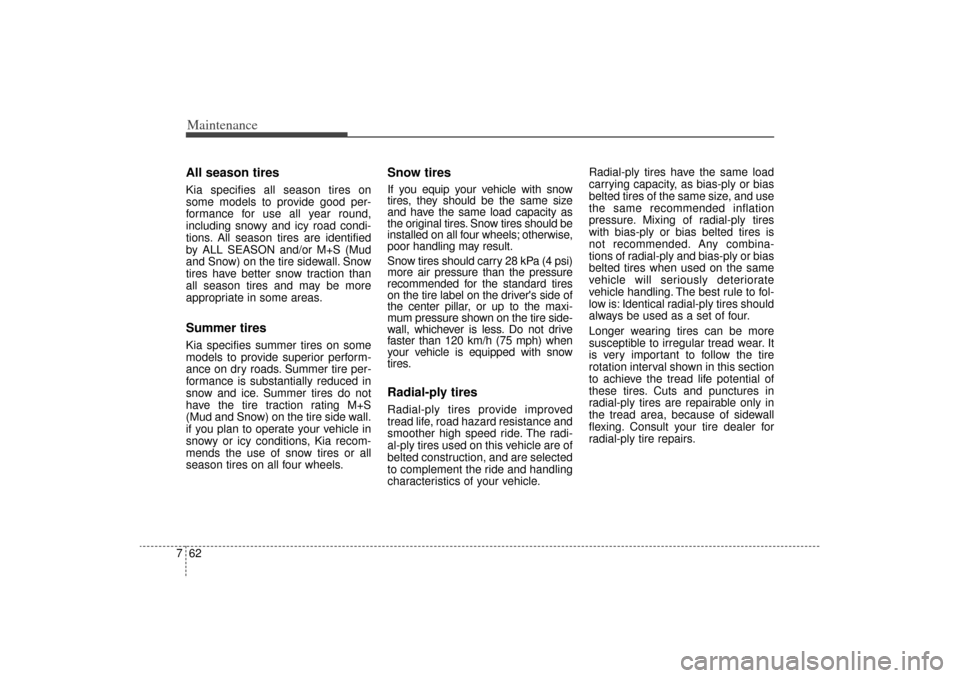
Maintenance62
7All season tires Kia specifies all season tires on
some models to provide good per-
formance for use all year round,
including snowy and icy road condi-
tions. All season tires are identified
by ALL SEASON and/or M+S (Mud
and Snow) on the tire sidewall. Snow
tires have better snow traction than
all season tires and may be more
appropriate in some areas.Summer tires Kia specifies summer tires on some
models to provide superior perform-
ance on dry roads. Summer tire per-
formance is substantially reduced in
snow and ice. Summer tires do not
have the tire traction rating M+S
(Mud and Snow) on the tire side wall.
if you plan to operate your vehicle in
snowy or icy conditions, Kia recom-
mends the use of snow tires or all
season tires on all four wheels.
Snow tiresIf you equip your vehicle with snow
tires, they should be the same size
and have the same load capacity as
the original tires. Snow tires should be
installed on all four wheels; otherwise,
poor handling may result.
Snow tires should carry 28 kPa (4 psi)
more air pressure than the pressure
recommended for the standard tires
on the tire label on the driver's side of
the center pillar, or up to the maxi-
mum pressure shown on the tire side-
wall, whichever is less. Do not drive
faster than 120 km/h (75 mph) when
your vehicle is equipped with snow
tires.Radial-ply tiresRadial-ply tires provide improved
tread life, road hazard resistance and
smoother high speed ride. The radi-
al-ply tires used on this vehicle are of
belted construction, and are selected
to complement the ride and handling
characteristics of your vehicle. Radial-ply tires have the same load
carrying capacity, as bias-ply or bias
belted tires of the same size, and use
the same recommended inflation
pressure. Mixing of radial-ply tires
with bias-ply or bias belted tires is
not recommended. Any combina-
tions of radial-ply and bias-ply or bias
belted tires when used on the same
vehicle will seriously deteriorate
vehicle handling. The best rule to fol-
low is: Identical radial-ply tires should
always be used as a set of four.
Longer wearing tires can be more
susceptible to irregular tread wear. It
is very important to follow the tire
rotation interval shown in this section
to achieve the tread life potential of
these tires. Cuts and punctures in
radial-ply tires are repairable only in
the tread area, because of sidewall
flexing. Consult your tire dealer for
radial-ply tire repairs.
XM(FL) CAN(ENG) 7.QXP 1/23/2013 3:37 PM Page 62
Page 467 of 508
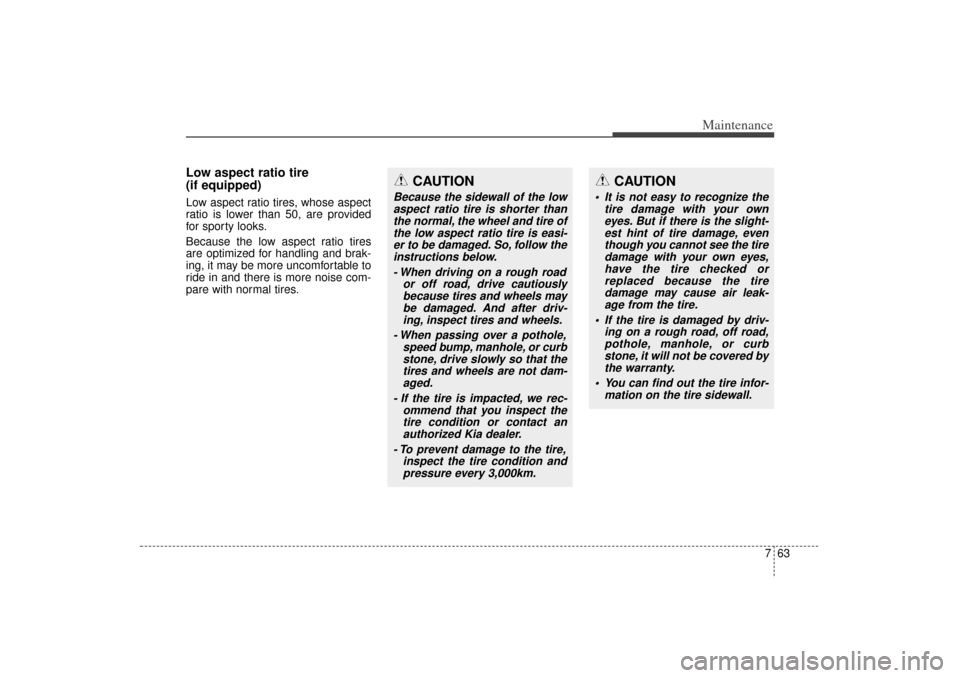
763
Maintenance
Low aspect ratio tire
(if equipped)Low aspect ratio tires, whose aspect
ratio is lower than 50, are provided
for sporty looks.
Because the low aspect ratio tires
are optimized for handling and brak-
ing, it may be more uncomfortable to
ride in and there is more noise com-
pare with normal tires.
CAUTION
Because the sidewall of the lowaspect ratio tire is shorter thanthe normal, the wheel and tire ofthe low aspect ratio tire is easi-er to be damaged. So, follow theinstructions below.
- When driving on a rough road or off road, drive cautiouslybecause tires and wheels maybe damaged. And after driv-ing, inspect tires and wheels.
- When passing over a pothole, speed bump, manhole, or curbstone, drive slowly so that thetires and wheels are not dam-aged.
- If the tire is impacted, we rec- ommend that you inspect thetire condition or contact anauthorized Kia dealer.
- To prevent damage to the tire, inspect the tire condition andpressure every 3,000km.
CAUTION
• It is not easy to recognize the tire damage with your owneyes. But if there is the slight-est hint of tire damage, eventhough you cannot see the tiredamage with your own eyes,have the tire checked orreplaced because the tiredamage may cause air leak-age from the tire.
If the tire is damaged by driv- ing on a rough road, off road,pothole, manhole, or curbstone, it will not be covered bythe warranty.
You can find out the tire infor- mation on the tire sidewall.
XM(FL) CAN(ENG) 7.QXP 1/23/2013 4:46 PM Page 63
Page 489 of 508
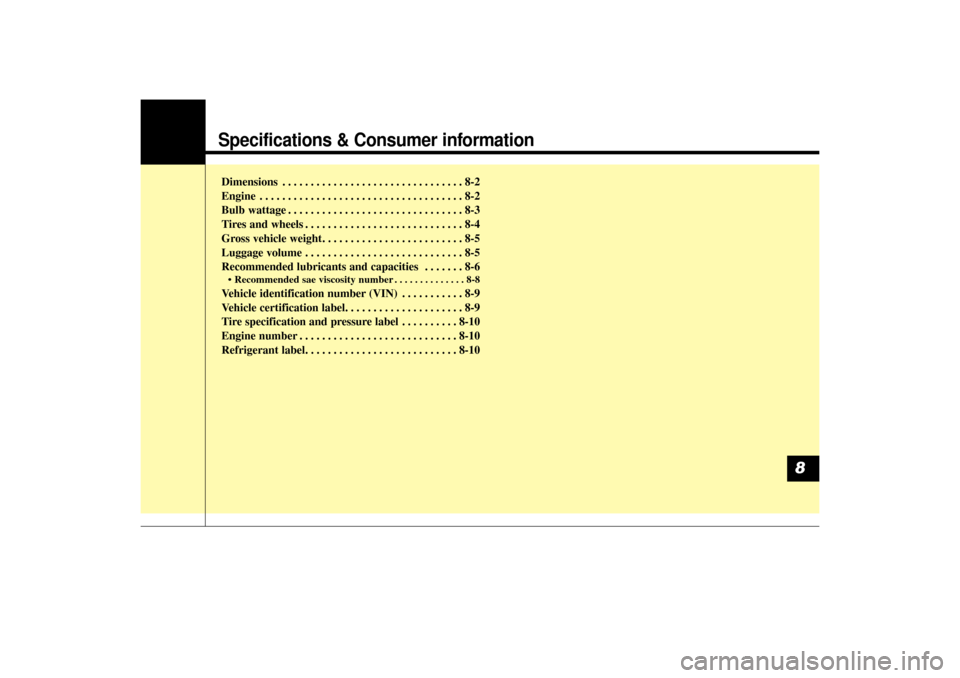
Specifications & Consumer informationDimensions . . . . . . . . . . . . . . . . . . . . . . . . . . . . . . . . 8-2
Engine . . . . . . . . . . . . . . . . . . . . . . . . . . . . . . . . . . . . \
8-2
Bulb wattage . . . . . . . . . . . . . . . . . . . . . . . . . . . . . . . 8-3
Tires and wheels . . . . . . . . . . . . . . . . . . . . . . . . . . . . 8-4
Gross vehicle weight. . . . . . . . . . . . . . . . . . . . . . . . . 8-5
Luggage volume . . . . . . . . . . . . . . . . . . . . . . . . . . . . 8-5
Recommended lubricants and capacities . . . . . . . 8-6• Recommended sae viscosity number . . . . . . . . . . . . . . 8-8Vehicle identification number (VIN) . . . . . . . . . . . 8-9
Vehicle certification label. . . . . . . . . . . . . . . . . . . . . 8-9
Tire specification and pressure label . . . . . . . . . . 8-10
Engine number . . . . . . . . . . . . . . . . . . . . . . . . . . . . 8-10
Refrigerant label. . . . . . . . . . . . . . . . . . . . . . . . . . . 8-10
8
XM(FL) CAN(ENG) 8.QXP 1/23/2013 4:01 PM Page 1
Page 492 of 508
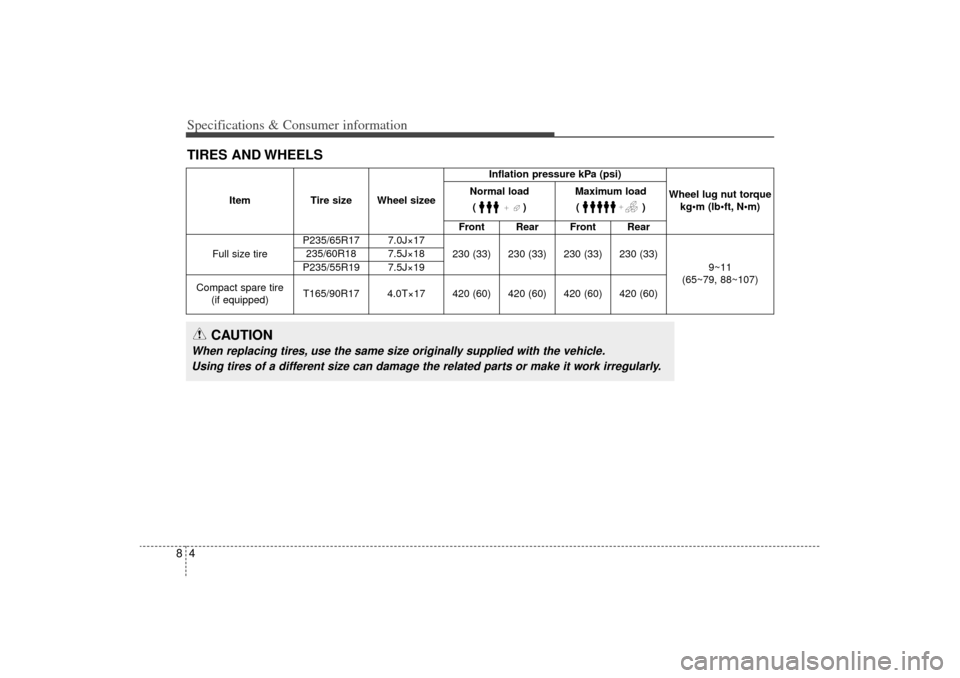
Specifications & Consumer information48TIRES AND WHEELS
ItemTire size Wheel sizee Inflation pressure kPa (psi)
Wheel lug nut torque kg•m (lbft, Nm)
Normal load
()
Maximum load()
Front Rear Front Rear
Full size tire P235/65R17 7.0J×17
230 (33) 230 (33) 230 (33) 230 (33)
9~11
(65~79, 88~107)
235/60R18 7.5J×18
P235/55R19 7.5J×19
Compact spare tire (if equipped) T165/90R17 4.0T×17 420 (60) 420 (60) 420 (60) 420 (60)
CAUTION
When replacing tires, use the same size originally supplied with the vehicle.
Using tires of a different size can damage the related parts or make it work irregularly.
XM(FL) CAN(ENG) 8.QXP 1/23/2013 4:01 PM Page 4
Page 498 of 508
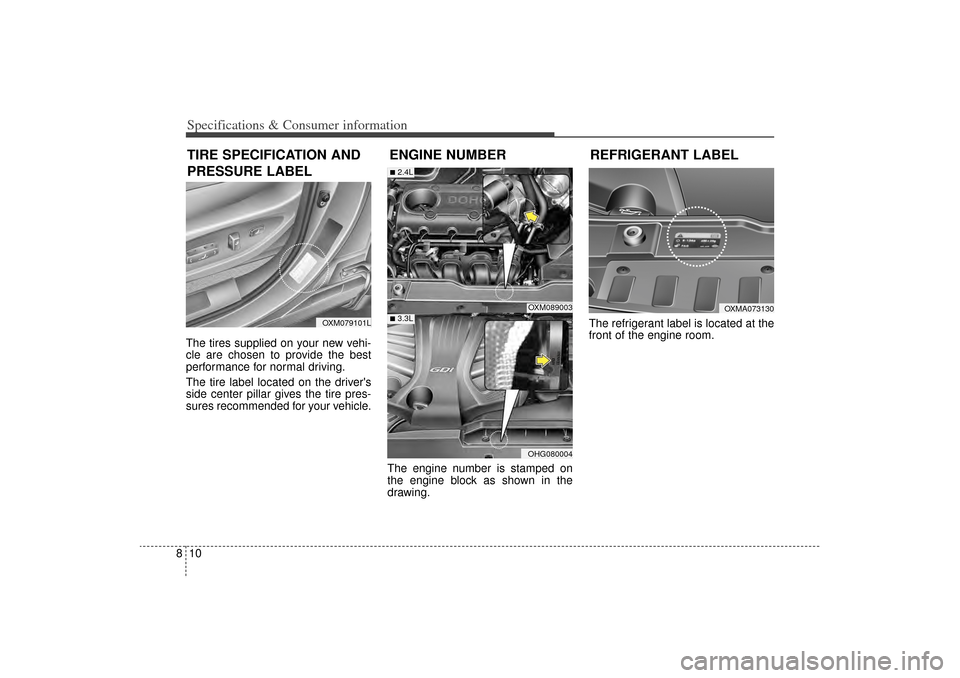
Specifications & Consumer information10
8The tires supplied on your new vehi-
cle are chosen to provide the best
performance for normal driving.
The tire label located on the driver's
side center pillar gives the tire pres-
sures recommended for your vehicle.
The engine number is stamped on
the engine block as shown in the
drawing.The refrigerant label is located at the
front of the engine room.TIRE SPECIFICATION AND
PRESSURE LABEL
ENGINE NUMBER
OXM079101L
OXM089003
■2.4L■3.3L
OHG080004
REFRIGERANT LABEL
OXMA073130
XM(FL) CAN(ENG) 8.QXP 1/23/2013 4:02 PM Page 10
Page 503 of 508

I5
Index
Flat tire ........................................................................\
....6-8Jack and tools ..............................................................6-8
Removing and storing the spare tire ..........................6-9
Changing tires ..........................................................6-11
Compact spare tire ....................................................6-15
Floor mat anchor(s) ....................................................4-155
Fluid ........................................................................\
......7-36 Brakes/clutch fluid ....................................................7-36
Washer fluid ..............................................................7-37
Fog light (front) ..........................................................4-112
Front seat adjustment - Manual ......................................3-5
Front seat adjustment - power ........................................3-6
Fuel Economy ................................................................4-89
Fuel filler lid ..................................................................4-40
Fuel Gauge ....................................................................4-72\
Fuel requirements ............................................................1-3
Fuse switch ....................................................................7-66\
Fuses ........................................................................\
......7-64 Instrument panel fuse ................................................7-65
Fuse switch ................................................................7-66
Multi fuse ..................................................................7-67
Fuse/relay panel description......................................7-68 Gauges ........................................................................\
..4-71
Glove box ....................................................................4-14\
6
Gross vehicle weight ......................................................8-5
Hazard warning flasher................................................4-107
Hazardous driving conditions ........................................5-57
Headlamp escort function ............................................4-108
Headlamp welcome ....................................................4-108
Headlamp welcome function ......................................4-108
Headrest(front) ..............................................................3-10
Headrest(rear) ................................................................3-22
Heated steering wheel....................................................4-51
Heater ........................................................................\
..4-131
Automatic climate control system ..........................4-131
High - beam operation ................................................4-111
Hight adjustment............................................................3-28
Highway driving ............................................................5-61
Hill-start assist control (HAC) ......................................5-41
Hood ........................................................................\
......4-38
Horn ........................................................................\
......4-51
How to use this manual ..................................................1-2F
GH
XM(FL) CAN(ENG) Index.qxp 1/23/2013 3:41 PM Page 5